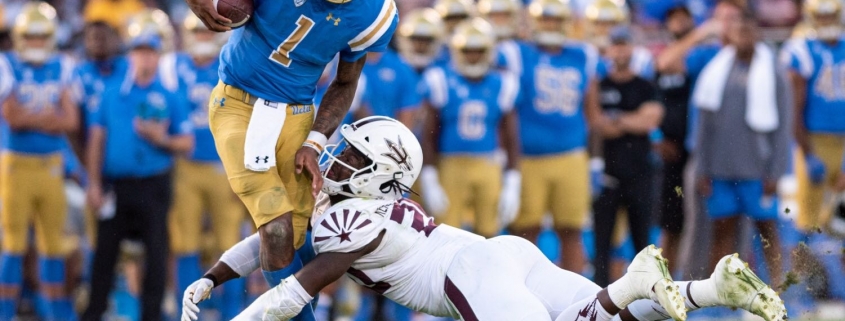Identifying the rival Bruins’ strengths and weaknesses

UCLA Offense
Base offense: Pro-style with a dash of pistol
Run-pass percentage: 53.9% run, 46.1% pass
Strength: Explosive plays
Weakness: Turnovers, converting on third down
X Factors: Redshirt junior running back Demetric Felton, redshirt freshman wide receiver Kyle Philips

For almost a month, it looked like the UCLA offense might be the best in the Pac-12. After a 1-5 start to the season, the Bruins appeared to have righted the ship, rattling off three straight double-digit wins against Pac-12 opponents on the back of the conference’s most productive offense.
Over that three-game stretch, UCLA averaged 36 points per game. In fact, in the team’s last six games before Saturday’s blowout loss to Utah, the Bruins posted a remarkably healthy 478 yards per game. They generated that offense in balanced fashion, averaging 261 yards through the air and 217 on the ground.
Head coach Chip Kelly has been willing to embrace a run-first philosophy, as evidenced by UCLA’s run-pass ratio in a conference where traditional pro-style stalwarts like USC have shifted to newer Air Raid systems.
Redshirt senior running back Joshua Kelley has been a force this year, rushing for 939 yards and 10 touchdowns so far. The Trojans shouldn’t need to look at the stat sheet to know what he can do — last year, he dropped 289 yards and two touchdowns on them as he led the Bruins past USC for the first time in four years. Kelley is a patient runner — he needs to be, given UCLA’s unreliable offensive line.
Kelley’s ability to produce at such a high level creates opportunities for sophomore quarterback Dorian Thompson-Robinson. Thompson-Robinson seems far more comfortable in this offense than he did last season, and it has shown in his ability to create big plays through the air.
Explosive plays are the calling card of this Bruin offense, and Thompson-Robinson’s deep ball makes that possible. When comfortable, he can hurl bombs.
He’s also improved at making short-area reads, something he struggled with early in his career. He has a handsome 17 touchdowns to go with 2,056 passing yards so far; he’ll likely end the season nearly doubling his output from last year.
Unfortunately for the Bruins, the sophomore has struggled mightily with ball protection. Thompson-Robinson has thrown 10 picks on the year, and he’s fumbled the football 10 times. Over the Bruins’ recent three-game win streak, it seemed that he and the team had improved in that regard, but last week’s matchup against Utah showed that progress to be little more than a mirage.
The Bruins turned the ball over five times — four courtesy of their quarterback — and were reduced to a smoking husk of themselves for the duration of the contest, held to a pitiful 3 points.
A big part of that collapse came because of an offensive line that couldn’t protect its quarterback. The Bruins gave up five sacks, and it was clear that Thompson-Robinson was rattled most of the night. UCLA can’t rely solely on Kelley and Thompson-Robinson to carry it; it needs strong outings from other weapons to get going.
Redshirt freshman wide receiver Kyle Philips is a capable threat on the outside, leading the team with five receiving scores. Redshirt junior Demetric Felton is as good of a multi-purpose running back as there is in the Pac-12, evidenced by his 807 scrimmage yards. Both will need to get involved in a critical game for an offense that needs to rediscover its identity.
UCLA Defense
Base defense: 3-4 with a lot of nickel
Blitz tendency: Medium
Strength: Splash plays
Weakness: Most things
X Factor: Sophomore safety Stephan Blaylock
This is not a good defense. UCLA allows an average of 33.7 points per game — “good” for 100th in the country — and gives up an abysmal 442 passing yards per game.
Though the Bruins allow a respectable 143.6 yards per game on the ground, there’s no area where they consistently find success as a unit. Their outing against Stanford was the group’s best; the Bruins allowed only 16 points and 198 yards on the night in a stifling performance.
The Bruins have plenty of talent on that side of the ball, which makes it possible for the defense to play better than its ranking at times. Senior linebackers Krys Barnes and Lokeni Toailoa are both adept at playing the run, and junior cornerback Darnay Holmes is an athletic marvel.
Blaylock sets the tone for the Bruins on defense, leading the team in tackles and forced fumbles. His ability to make plays in both the run and short passing game is a huge boost for the Bruins, but mistakes like blown tackles are a consistent issue for him. What version of Blaylock shows up Saturday will have a lot to do with how well UCLA counters freshman quarterback Kedon Slovis and the USC passing attack.
The Bruins are liable to get torched in the secondary, and their pass rush is no serious threat either. It’s likely that their recent defensive “success” was a result of the poor offensive opponents. After all, this is the same unit that gave up 63 points to Washington State only seven games ago. One way or another, UCLA will have its hands full this week with Slovis and the Trojan offense coming off of a dominant 462-yard, five-touchdown performance against Cal.
Take a look at the rest of our collaboration with The Daily Bruin:


